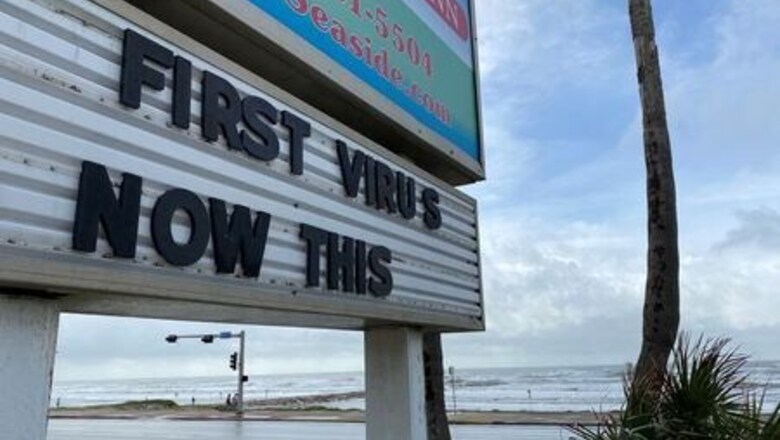
views
PORT ARTHUR, Texas: Hurricane Laura made landfall early on Thursday in southwestern Louisiana as one of the most powerful storms to hit the state, with forecasters warning it could push a massive wall of water 40 miles (65 km) inland from the sea.
The National Weather Service said the storm surge, possibly higher than a two-storey house, could be “unsurvivable,” acknowledging that as an unusually dire warning.
Laura crashed ashore around 1 a.m. Central Time (0600 GMT) as a Category 4 storm, the second strongest on the five-step scale, packing winds of 150 mph (240 kph) in the small town of Cameron, Louisiana, the National Hurricane Center (NHC) said.
Besides threatening life, the storm was barreling toward the heart of the U.S. oil industry, forcing oil rigs and refineries to shut down production.
“The eyewall of Laura will continue to move inland across southwestern Louisiana during the next several hours,” the NHC said in a early Thursday bulletin. “TAKE COVER NOW!”
Maximum sustained winds had slowed to 120 mph (195 kph), but were still strong enough to blow out windows in Lake Charles’ 22-floor Capital One Tower, social media imaged showed.
Officials across the hard-hit area said it would be several hours before they could get out to begin search and rescue missions. Downed trees blocking roadways were expected to be the biggest immediate challenge for rescuers.
About 620,000 people were under mandatory evacuation orders in Louisiana and Texas, but officials acknowledged many people would choose to stay home.
In Vermilion Parish, just east of Laura’s landfall, the sheriff’s office gave them a stark warning.
“If you choose to stay and we can’t get to you, write your name, address, social security number and next of kin and put it a ziplock bag in your pocket,” read a statement on the sheriff’s Facebook page.
VODKA AND SHELTER
Hurricane-strength winds could blow as far as 200 miles inland to Shreveport, Louisiana, forecasters said.
The oil-refining town of Port Arthur, a city of 54,000, was a ghost town late on Wednesday, with just a couple of gas stations and a liquor store open for business.
“People need their vodka,” said Janaka Balasooriya, a cashier, who said he lived a few blocks away and would ride out the storm at home.
The area where Laura made landfall is marshy and particularly vulnerable to the storm surge of ocean water.
“This is one of the strongest storms to impact that section of coastline,” said David Roth, a forecaster with the National Weather Service. “We worry about that storm surge going so far inland there because it’s basically all marshland north to Interstate 10. There is little to stop the water.”
The storm surge could penetrate inland from between Freeport, Texas, and the mouth of the Mississippi River, and could raise water levels as high as 20 feet (6 meters) in parts of Cameron Parish, Louisiana, the NHC said.
“To think that there would be a wall of water over two stories high coming on shore is very difficult for most to conceive, but that is what is going to happen,” said National Weather Service meteorologist Benjamin Schott at a news conference.
“The word ‘unsurvivable’ is not one that we like to use, and it’s one that I’ve never used before,” Schott said of the storm surge.
Temporary housing was hastily organized outside the surge zone for evacuated residents, and emergency teams were being strategically positioned, state and federal emergency management agencies said.
Laura was also expected to spawn tornadoes on Thursday over Louisiana, far southeastern Texas and southwestern Mississippi, with widespread flooding likely from far eastern Texas across Louisiana and Arkansas.
Disclaimer: This post has been auto-published from an agency feed without any modifications to the text and has not been reviewed by an editor



















Comments
0 comment